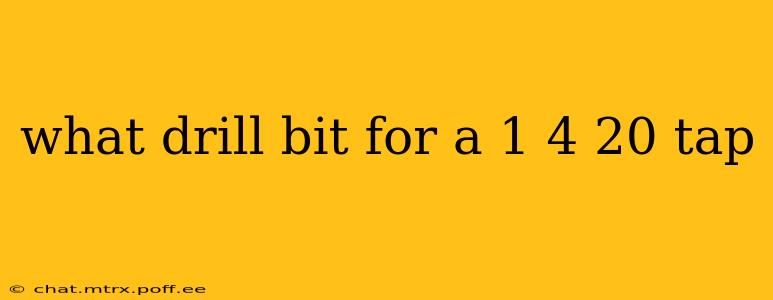Choosing the right drill bit for tapping a 1/4-20 thread is crucial for ensuring a clean, accurate, and strong thread. Using the wrong size can lead to stripped threads, a broken tap, or a poor-fitting fastener. This guide will walk you through selecting the appropriate drill bit, addressing common questions and concerns.
What Size Drill Bit Do I Need for a 1/4-20 Tap?
The most common recommendation for a 1/4-20 tap is a #7 drill bit. This corresponds to a diameter of 0.201 inches. This size leaves enough material for the tap to cut clean threads without excessive pressure. Using a smaller drill bit risks breaking the tap, while a larger bit will result in weak threads.
Why Use a #7 Drill Bit for a 1/4-20 Tap?
The #7 drill bit provides the correct clearance for the 1/4-20 thread. The tap needs sufficient material to engage and cut the threads properly. Using a smaller bit would cause the tap to bind and potentially break. A larger bit leaves insufficient material resulting in weak, stripped, or unusable threads.
What Happens if I Use the Wrong Size Drill Bit?
Using an incorrect drill bit size can lead to several problems:
- Broken Tap: If the hole is too small, the tap will bind, creating excessive pressure that can snap the tap. This is a frustrating and time-consuming problem to fix.
- Stripped Threads: If the hole is too large, the threads cut by the tap will be weak and prone to stripping when a screw is inserted. This means the screw won't hold securely.
- Poorly Fitting Fastener: An incorrectly sized hole leads to a loose or poorly fitting fastener. This compromises the strength and reliability of the joint.
What are the Different Types of Drill Bits?
Several drill bit types can be used, but high-speed steel (HSS) bits are generally preferred for tapping threads. These are durable and can withstand the stresses involved in cutting threads. Consider using a lubricant with your HSS drill bit to aid in the cutting process and extend its lifespan.
How Can I Ensure Accuracy When Drilling?
Accuracy is paramount when drilling for tapping. Here are some tips for ensuring accurate holes:
- Use a vise: Secure your workpiece firmly in a vise to prevent movement during drilling.
- Start slowly: Begin drilling at a low speed to prevent the bit from walking or slipping.
- Apply even pressure: Avoid excessive pressure, which can cause the bit to overheat and break.
- Use a drill guide: For precise hole placement, especially in thin materials, use a drill guide or bushing.
What are the Alternatives to a #7 Drill Bit?
While a #7 drill bit is the standard recommendation, there might be slight variations depending on the specific tap and material being used. Always consult the tap manufacturer's specifications for the most precise drill size recommendation.
Conclusion: Precision is Key
Selecting the correct drill bit size for a 1/4-20 tap is crucial for success. A #7 drill bit (0.201 inches) is generally recommended, providing the optimal clearance for clean, strong threads. Remember to use proper drilling techniques and consider using a lubricant to ensure a smooth and efficient process. Always prioritize accuracy to avoid costly mistakes.
